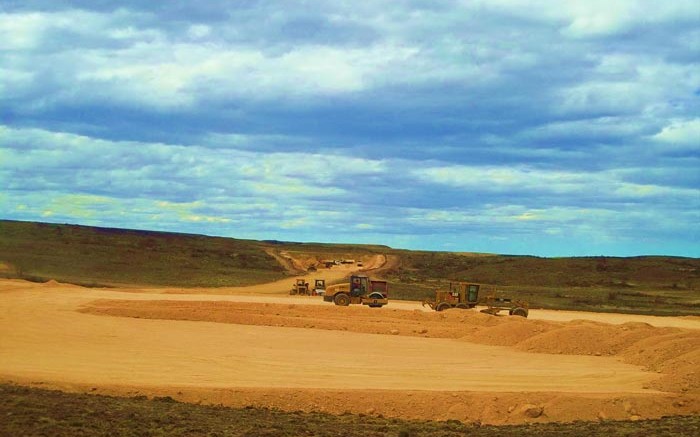VANCOUVER — It’s become relatively rare to see intermediate gold producers commit capital to new developments, but Yamana Gold (TSX: YRI; NYSE: AUY) is bucking the trend at its Cerro Moro low-sulphidation epithermal deposit in Santa Cruz province, Argentina. On Feb. 11 the company revealed it is moving ahead with a US$265-million development at the project, setting the stage for first production in 2017.
Yamana’s plan would add 102,000 oz. gold and 5 million oz. silver to its annual production. Due to higher average grades early on, the mine is scheduled to crank out 135,000 oz. gold and 6.7 million oz. silver annually in its first three years.
Cerro Moro’s cash costs would be in the lowest-quartile. All in sustaining costs are estimated at US$557 per oz. gold and US$7.80 per oz. silver over the mine’s life.
The company conducted optimization work over the past two years before opting for a single-stage plant scenario with a 1,000-tonne-per-day capacity. The plant construction provides for less project execution, inflation and timing risk by allowing for the mine to be built in less time with the same workforce.
Some 933,000 tonnes of ore at a grade of 6.37 grams gold per tonne and 394 grams silver per tonne would come from small open pits on the Escondida, Gabriela, Zoe, Loma, Deborah, Carla, Patricia and Nini vein deposits. Another 1.6 million tonnes grading 13.48 grams gold and 621 grams silver would come from underground mines on the Escondida, Zoe and Gabriela veins.
The project boasts probable reserves of 2 million tonnes grading 11.38 grams gold and 648 grams silver for 715,000 contained oz. gold and 41 million contained oz. silver. Indicated resources total 3.3 million tonnes of 2.23 grams gold and 190 grams silver, while inferred resources add 4.4 million tonnes averaging 1.96 grams gold and 101 grams silver.
“We applied lessons learned at our development-stage projects towards the plans at Cerro Moro,” chairman and CEO Peter Marrone noted during a mid-February conference call. “We’ve really streamlined our management, improved the quality of our people, and focused on driving costs down. We’re looking to build confidence through the continuity and stability of our cornerstone assets and the delivery of new cornerstone asset.”
Total project capital over the mine’s life is expected to be US$398 million, which includes US$265 million in initial capital and US$133 million life-of-mine sustaining capital. Based on metal prices of US$1,265 per oz. gold and US$17.60 per oz. silver, Cerro Moro features a 26% after-tax internal rate of return and a three-year payback.
Cerro Moro boasts a few logistic advantages that underpin Yamana’s confidence in the project. The site sits slightly above sea level on flat terrain, and is connected by a nearby, 70 km highway to the fishing city of Puerto Deseado, which has a port suited for heavy equipment transport.
The company also has operational experience in Argentina, with its Gualcamayo and Alumbrera mines currently producing in the country.
“You’ve heard me say before that I think Argentina has an improving socio-economic and geopolitical state, certainly from a mining company’s perspective,” Marrone said. “There are definitely some potential impacts from engaging in the development of a country … we’ve definitely seen that improvement.”
After the Cerro Moro announcement, Yamana released its annual financial results.
The company set an annual production record in 2014 by cranking out 1.4 million equivalent oz. gold at all-in sustaining cash costs of US$774 per oz. Annual adjusted earnings came in at US$41.5 million, or 5¢ per share, which compares to earnings of US$274 million, or 36¢ per share in 2013. The company also reported US$904 million in impairment charges.
“It was a year of reconciliation for us. We needed to reconcile certain things that we did not do right originally, so those impairments have impacted our earnings, but we think that we now have a better reflection of the book value of our assets and the potential moving forward,” Marrone added, noting Yamana finished the year with cash and available credit totalling US$781 million.
Yamana expects to produce 1.3 million oz. gold, 9.7 million oz. silver and 190 million lb. copper this year. The company estimates all-in sustaining cash costs should fall between US$800 and US$830 per oz. gold and US$9.50 and US$9.80 per oz. silver. Expansionary capital is expected to total between US$90 and US$140 million in 2015, with a large amount earmarked for construction at Cerro Moro.
BMO Capital Markets analyst Dave Haughton labelled the company’s annual results “slightly negative,” and downgraded his stock rating to “market perform.” Haughton also dropped his target price by 75¢ to $5.75 per share.
“Higher-than-expected ‘other operating expenses’ contributed to the earnings miss,” he added. “BMO Research is downgrading [Yamana] following the weaker-than-expected guidance for 2015–17.”
Yamana has traded within a 52-week window of $3.93 and $11.86, and closed at $4.90 per share at press time. The company has 938 million shares outstanding for a $4.8-billion market capitalization.


Be the first to comment on "Yamana aims to apply ‘lessons learned’ at Cerro Moro"